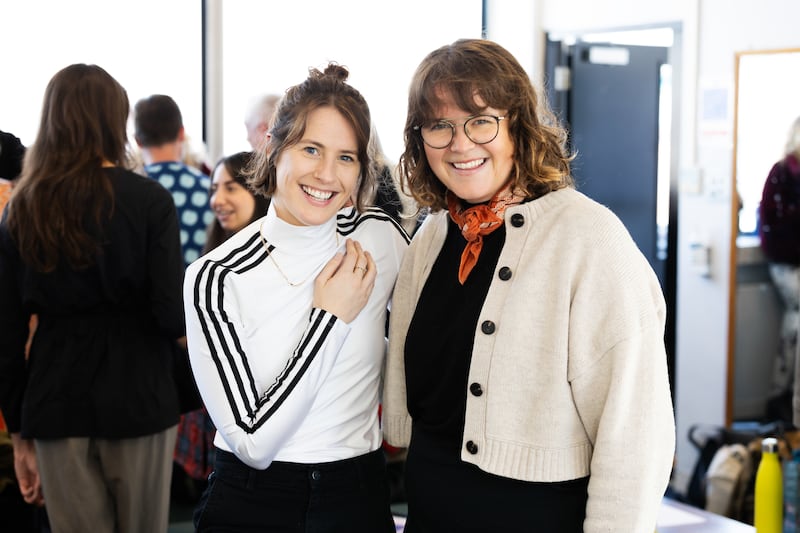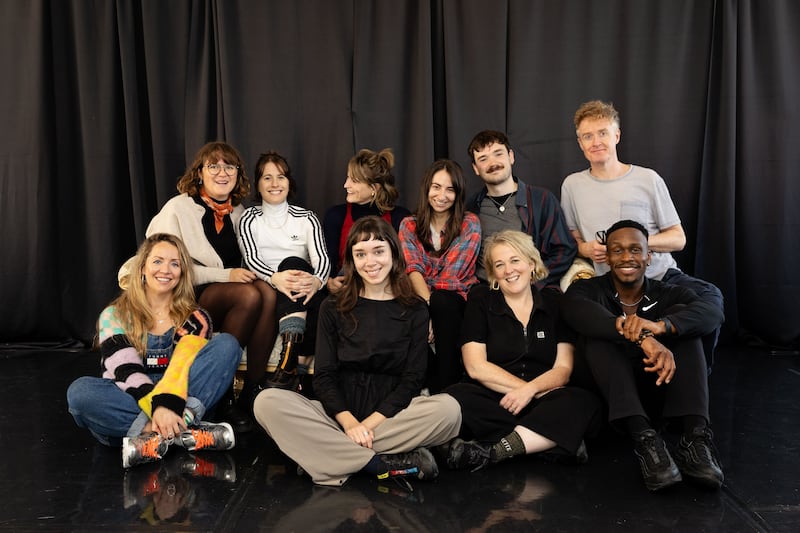It’s a good job we’ve moved from the upstairs lobby bar of the Abbey Theatre into a dressingroom, because this interview is rowdy and raucous, with a lot of laughing. Not that it isn’t a hard-working rehearsal, but it sounds like the gang is having a blast with a reworking of Jane Austen’s Emma, for the national theatre’s Christmas show.
The Abbey doing Jane Austen: “Huh? Like the Gate of old?” you might say. But this isn’t a straight period-frock drama. For a start it’s a contemporary adaptation by the US actor and playwright Kate Hamill, being pitched as a reimagining of Emma for the “brat”-Bridgerton era. Then it’s directed by Claire O’Reilly, a founder of Malaprop, the bold, inventive theatre collective, with Emma played by sparky rising star Toni O’Rourke. In the dressingroom they tell me rehearsals are “a ludicrous amount of fun, and hopefully that translates”.
“It’s a real gift for me directorially,” says O’Reilly, a former resident director at the Abbey. “You take a British Regency novel that’s set in a fictional, prosperous village, via Kate Hamill’s American screwball-comedy lens, then you stage it in the Abbey with Irish actors. You really dilute place. But it’s very faithful to plot and the essence of these characters.”
As well as “slightly distilled” place, the adaptation “lives in playful acknowledgment of the theatre itself and the audience. Emma speaks to the audience. It makes the other conventions of Austen’s world quite elastic in terms of vernacular or social convention.”
O’Rourke loves the fun and playfulness they’re bringing to it, and finds the adaptation surprisingly true to Austen’s 1815 comedy of manners. “When you read Jane’s book, you’re kind of shocked.” For example, “the concept of ‘friend-zoning’ is in it. Gosh, we’ve been doing that since the early 1800s? We think we’ve progressed so greatly, yet we’re still having all these human experiences.”
“It’s still Jane Austen’s Emma,” says O’Reilly, “very much a literary classic in that sense”, so on the face of it quite a change for the director. She talks about tone, sensibility, sound design and visuals. “There are Regency leanings, but we have this permission to play within that.” Romance and relationships are cyclical, so while much in Austen’s world is unrecognisable to us, including “the confines and limitations imposed on women, and indeed the men. The social etiquette has evolved dramatically, but the feelings and some of the ideas are really persistent.” She mentions encountering Emma via Clueless, the 1995 film version starring Alicia Silverstone, being surprised that a scene where a memory-box of keepsakes was burned (“so ‘90s-teen-drama”) wasn’t a Clueless fabrication, but occurs in the novel.
Emma involves relationships, parties, romantic pairings within a small social circle, and the botched matchmaking of the central character. Austen famously wrote that Emma was “a heroine whom no one but myself will much like”. Handsome, clever and rich, she’s also spoiled, headstrong, self-satisfied, a meddler.
She is, says O’Rourke, “very forward in her self-love, her belief in self. She’s very confident. Overconfident. And slightly arrogant and conceited. But she’s very intelligent.” It wasn’t only Austen who loved her: “Of course, we all love Emma. We can recognise ourselves in her faults and the messiness of it all. She may think she is perfect, but she’s got a long way to go. She’s quite endearing and childlike in ways.”

O’Reilly adds: “Yes, she can be arrogant and chaotic, but she is genuinely interested in people and she’s really curious about the world around her, her social context, and also herself.” Hamill’s script explores “the psychology around what drives her, even when she’s being manipulative or myopic. I adore her as a character. I think if I ran into her, I’d love to party with her!”
Toni O’Rourke, familiar from screens and a talent to watch, is relishing playing Emma. Earlier this year she was in RTÉ’s The Boy That Never Was, exhibiting quite a range, from tough drama to comic silliness.
I get asked a lot about the men I work with. I don’t see male costars being asked about me or other women they work with
— Toni O'Rourke
She hails from Dún Laoghaire, Co Dublin, and moved to London four years ago, during the pandemic. “It was a crazy time, but it served me. I love London. We’ve got a really special community there [of Irish actors and creative people].” O’Reilly is also based in London – and, shockingly, both agree that life and rent are more affordable in London than in Dublin.
“But I also love coming home. And to be doing this show, it feels like a great honour, on our national stage.” Somehow in interviews O’Rourke is often asked about famous friends, from Paul Mescal to Barry Keoghan. She’s very gracious, saying “it’s lovely to speak of all successes, of all people”. She’s also bemused, “I get asked a lot about the men I work with. I think a lot of us are defined by the success of the men around us. What I will say is,” and she’s grinning, “I don’t see male costars being asked about me or other women they work with.”
“Plotwise, everything is intact,” says O’Reilly of Hamill’s adaptation. She calls it “a collaboration between the then and now on every level. Some of the syntax and vocab is very Regency, and some of the ideas and sentences are lifted straight from the novel. The luxury of the novel form is you can really dig into every thought and idea. But what she has done so beautifully is inject pace and momentum into the storytelling. There are some extremely contemporary quips and responses.”
O’Reilly had not read Jane Austen’s Emma when she got the call from the Abbey. If she was surprised at a period-pitch given her style, after reading Hamill’s play, she understood where they were coming from.
O’Rourke: “Also, no better woman.”
O’Reilly: “Silly, you say?”
O’Rourke: “Fun and glamorous. Just so fab.”
O’Reilly returns the compliment. “To work with someone who’s so comedic and so generous ... That’s true of Toni, but also the whole ensemble.”
O’Rourke did an audition via video while working in Paris. “I read this script. I haven’t done theatre for a number of years. I said my heart will be in a million pieces if I don’t get this! I knew the team involved. I’ve been dying to work with Claire for years. This piece just felt like the perfect amalgamation of the right project, right time.”
The last time she was on a stage was for one night in Good Sex, Dead Centre’s 2022 Dublin Theatre Festival show, where two actors who didn’t know each other were fed their lines through earphones for a performance mediated by an intimacy co-ordinator (an advocate liaising with actors to choreograph a sexual or exposing scene). “That was such a remarkable experience. I mean, it’s the actor’s nightmare, and we turned it into the dream, because there’s no pressure” because it’s managed by an intimacy co-ordinator.
Funnily enough, her partner that night was Patrick Martins, who’s now playing Knightly, Emma’s friend and confidant. “We already had a baseline language. So it was lovely.” The sparkling cast of eight, many making their Abbey main-stage debuts, includes Clare Barrett, Liz Fitzgibbon, Ciara Berkeley, Domhnall Herdman, Hannah Mamalis and Damian Kearney.

O’Reilly describes the show as “a kind of a hyper Regency-era”. It also features “hyper-pop”, meaning a maximalist, extreme pop, with lots of references and layers of ideas, by sound designer Jenny O’Malley. Catherine Fay’s costumes, too, marry Regency with playfulness.
Talking about the aesthetic, we ask set designer Molly O’Cathain to pop down from the stage for a minute. “We’re doing this together, building the world. She’s so gifted,” says O’Reilly; another Malaprop founder, they’ve worked together lots. The set, made in several places, has just arrived, and they’re building it onstage. It is very blue. “They drink a lot of tea. We started with a colour palette from blue and white china teacups,” says O’Cathain.
The other visual anchor was the notion of “an adult playground, that these people don’t have real jobs, they’re living a frivolous life where their various social engagements are like an occupation”. The playground as theatrical space “riffs on the classic period drama set where you do a big, grand staircase. Instead, ours is bright blue, trying to play with these two worlds, the formal period drama and the contemporary. And always looking for things to serve theatricality. It’s a big show with loads of moments, and we wanted it to be robust and fun and offer the actors lots of opportunity.”
Of Emma, O’Reilly observes she has suitors, money, looks, charm and privilege. “She’s so socially capable. She has everything. But what does she actually want? A central question I had reading both the novel and the play, is: what is going on with Emma’s libido? She is fixated on matchmaking, despite having very loose credentials. Is she aware she’s projecting and deflecting all of these repressed ideas? She’s perennially single. Our production is curious about her libido.”
But most of all for this Christmas production, as O’Rourke says: “We have a licence to laugh. I do think sometimes the world needs love and laughter and joy, and that can be quite cathartic in a very difficult world to exist in.”
They are laughing lots. “It’s very fun,” says O’Reilly. “It’s very silly, it’s very playful, but it’s also very self-aware. We have this amazing central character who’s a really complex female lead, on a journey of self-discovery. That’s a very modern idea.”
Emma, by Jane Austen, adapted by Kate Hamill, previews at the Abbey Theatre, Dublin, from Friday; it then opens on Thursday, November 28th, and runs until Saturday, January 25th



















